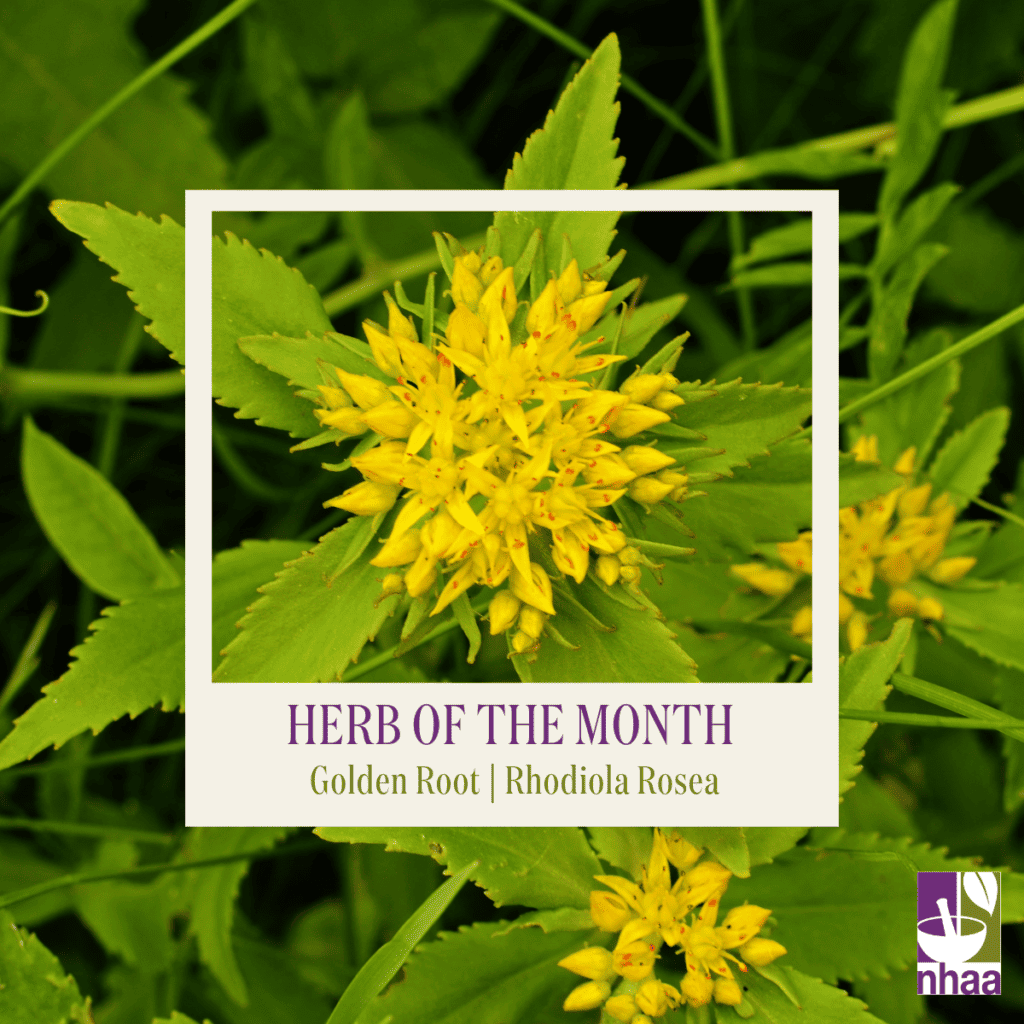
🌿This month’s Herb of the Month is Rhodiola, Golden Root or Rhodiola rosea (R. rosea).
Family: Crassulaceae
Part Utilised: Root or Rhizome
🌿Botanical name and description
Rhodiola rosea (R. rosea) is a yellow flowered, herbaceous perennial plant found in high altitudes, mountainous crevasses and sea cliffs in Arctic areas of Europe and Asia as well as east coast areas of North America (1, 2). Generally, R. rosea grows a compact 5 – 40cm with multiple stems extending out from dense rhizomes blanketing the surface areas of its occupation (7). Its vibrant yellow blooms appear in the summer months and the therapeutic raw materials are harvested in August and September, when components of the plant have matured satisfactorily (2, 7).
🌿History and traditional use
Evidence of R. rosea’s therapeutic application can be found globally with countries such as Norway, France, Sweden, Russia and China recording its use and efficacy over centuries (4, 5). Arguably, the primary literary recognition of its therapeutic properties were first evidenced within Dioscorides’ De Materia Medica appearing as Rodia riza with Carl Linnaeus later renaming the plant as it is known today due to its similar odor to rose oil (7, 1). Its historical versatility both in symptom management and prescriptive formats saw it applied as a functional food, extract, tonic and decoction in support of mental clarity and stamina, fatigue, depression, inflammation as well as for altitude sickness resistance and a prolonged longevity (4, 6). Tibetan, Mongolian and Viking medicinal practices utilised extracts from the root in the treatment of anaemia, cancers and physical stamina in battle respectively (7). It is easy to see why this herb was often traditionally thought of as a therapeutic panacea.
🌿Actions and contemporary usage
Whilst R. rosea’s historical uses remain relevant within contemporary herbal practices, its present-day analysis has gradually revealed a plethora of bioactive compounds and constituents, expanding our comprehension, therapeutic potential and safe clinical application of the herb (4, 3). It is an effective adaptogen, physical and cognitive stimulant, antioxidant, anti-inflammatory, hypoglycaemic and is additionally utilised for its anti-cancer and anti-anaemic properties (1, 2, 7). All of these properties additionally contribute to R. rosea’s efficacy and application in cardiovascular functionality and protection as well as reproductive health, potentially moderating cardio-tissue dysfunction and reducing vascular stressors to minimise physical and cognitive stress-induced dysfunction (1).
Due to the versatility, potency, traditional and contemporary research, R. rosea is currently under threat from commercial harvesting and global demand. Fields of alternative medicine, botany, pharmacology and phytomedicine have placed the herb under a time-sensitive pressure for conservation and protection, presenting practitioners with an ethical quandary as to its clinical application, use and prescription (8).
🌿Science and clinical Trials
Scientific research involving R. rosea’s efficacy in relation to mental health conditions has been evaluated in random control trials (RTCs) analysing its influence over cognitive function and mental support via its proposed stimulation of dopamine, serotonin and norepinephrine neurotransmitter activity (3). Studies have demonstrated that overall, extracts of R. rosea were generally well tolerated, ameliorating memory and attention along with mental resilience and accuracy, measurably alleviating depressive episodes (3, 1).
Constituents such as alkaloids, glycosides, volatile oils and phenolic compounds (to name just a few) have demonstrated neutrilising behaviours of free radicals, scavenging reactive oxygen species mitigating oxidative stressors and chronic inflammation systemically (4, 7). R. rosea’s extracts and bio active compounds have more recently been applied in the immunostimulation and DNA repair by isolating salidroside, a potent phenylpropanoid glycoside to reduce angiogenesis via downregulation and inhibition of mTOR pathways, stimulating paracrine functionality and promoting neovascularisation (2). These promising applications are evidenced to be even more significant by salidroside’s highly bioavailable and water-soluble oral administration, making it an accessible and easily excreted therapeutic potential (2).
Clinically, the therapeutic potential of R. rosea is vast and its application versatile. As with many alternative therapies and pharmacognosies, more research and high quality trials would benefit practitioners to effectively comprehend any scientific dark areas still evident within the research of R. rosea to ensure best, safest practice in all potential prescriptions.
🌿References
1. Ivanova Stojcheva E, Quintela JC. The Effectiveness of Rhodiola rosea L. Preparations in Alleviating Various Aspects of Life-Stress Symptoms and Stress-Induced Conditions-Encouraging Clinical Evidence. Molecules. 2022 Jun 17;27(12):3902. doi: 10.3390/molecules27123902. PMID: 35745023; PMCID: PMC9228580.
2. Li Y, Pham V, Bui M, Song L, Wu C, Walia A, Uchio E, Smith-Liu F, Zi X. Rhodiola rosea L.: an herb with anti-stress, anti-aging, and immunostimulating properties for cancer chemoprevention. Curr Pharmacol Rep. 2017 Dec;3(6):384-395. doi: 10.1007/s40495-017-0106-1. Epub 2017 Sep 14. PMID: 30393593; PMCID: PMC6208354.
3. Sharma A, Gerbarg PL, Brown RP. Non-Pharmacological Treatments for ADHD in Youth. Adolesc Psychiatry (Hilversum). 2015;5(2):84-95. doi: 10.2174/221067660502150430154937. PMID: 27489754; PMCID: PMC4968082.
4. Tao H, Wu X, Cao J, Peng Y, Wang A, Pei J, Xiao J, Wang S, Wang Y. Rhodiola species: A comprehensive review of traditional use, phytochemistry, pharmacology, toxicity, and clinical study. Med Res Rev. 2019 Sep;39(5):1779-1850. doi: 10.1002/med.21564. Epub 2019 Jan 16. PMID: 30652331.
5. Shikov AN, Pozharitskaya ON, Makarov VG, Wagner H, Verpoorte R, Heinrich M. Medicinal plants of the Russian Pharmacopoeia; their history and applications. J Ethnopharmacol. 2014 Jul 3;154(3):481-536. doi: 10.1016/j.jep.2014.04.007. Epub 2014 Apr 15. PMID: 24742754.
6. Chiang HM, Chen HC, Wu CS, Wu PY, Wen KC. Rhodiola plants: Chemistry and biological activity. J Food Drug Anal. 2015 Sep;23(3):359-369. doi: 10.1016/j.jfda.2015.04.007. Epub 2015 May 29. PMID: 28911692; PMCID: PMC9351785.
7. Bernatoniene J, Jakstas V, Kopustinskiene DM. Phenolic Compounds of Rhodiola rosea L. as the Potential Alternative Therapy in the Treatment of Chronic Diseases. Int J Mol Sci. 2023 Jul 31;24(15):12293. doi: 10.3390/ijms241512293. PMID: 37569669; PMCID: PMC10418374.
8. Brinckmann JA, Cunningham AB, Harter DEV. Running out of time to smell the roseroots: Reviewing threats and trade in wild Rhodiola rosea L. J Ethnopharmacol. 2021 Apr 6;269:113710. doi: 10.1016/j.jep.2020.113710. Epub 2020 Dec 31. PMID: 33358852.